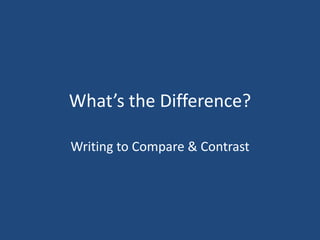
Compare contrast3
- 1. What’s the Difference? Writing to Compare & Contrast
- 2. Comparison & Contrast • Purpose: Helps us to understand one subject by seeing it in relation to another; helps evaluate • Essential for learning, evaluating, & decision making • Compare= similarities • Contrast= differences • One of the most difficult patterns
- 3. Drafting • What is your purpose? Who is your audience? • Prewriting: Identify Points of Comparison; limit scope • Introduction: What is your thesis? What are your subjects? What is the basis for your comparison/contrast? • Body Paragraphs: Choose the organizational pattern that best suits purpose • Conclusion: Summarizes point & draws logical conclusions
- 4. Using an Analogy • Special type of comparison • Used to clarify an unfamiliar or complex subject by pointing out similarities to something concrete • Compares two dissimilar subjects • No direct relationship is drawn • EXAMPLES: – Art of Writing/ Art of Carpentry – Earth’s Atmosphere/Window
- 5. Point-by-Point (Alternating) I. MPG I. Car A II. Car B II. Handling I. Car A II. Car B III. Special Equipment I. Car A II. Car B
- 6. Subject-by-Subject (Divided or Block) I. Car A I. MPG II. Handling III. Special Equipment II. Car B I. MPG II. Handling III. Special Equipment
- 7. Transitions • Compare: • Contrast: – In comparison to – In contrast to – Likewise – Another point of – Similarly distinction – One similarity…another – One difference..another similarity difference – Just as – Unlike – Again – While – As – Conversely – Too – On the contrary – In the same way – Rather than